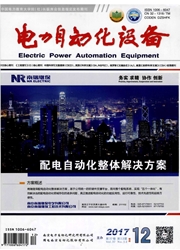

 中文摘要:
中文摘要:
根据某海岛的微电网结构建立了电磁暂态仿真模型,其包含4种微电源:储能、柴油发电机、直驱风机和光伏发电单元.在模型中设置多种故障,分析相应的故障特征及故障对传统继电保护的影响,并得出如下结论:在各微电源故障期间均能提供一定的故障电流,并且其自身保护按低电压穿越要求整定的前提下,馈线上的电流速断保护受各微电源故障电流受限的影响无法使用,而过电流保护受影响很小;电网电压严重跌落时,采用PQ控制的微电源故障电流频率将偏离工频,由此可能导致故障馈线母线侧的过电流保护失效,此时只能依靠纵联保护;在包含PQ控制的微电网中,不应配置基于故障分量的继电保护装置.
 英文摘要:
英文摘要:
A electromagnetic transient simulation model is built according to the microgrid topology of an island,which contains four kinds of microsource:battery storage,diesel generator,direct-driven wind turbine and photovoltaic unit.Different faults are set in the model,and the corresponding fault characteristics,as well as their influences on traditional relay protection,are analyzed.Conclusions:on the condition that all microsources can provide fixed fault current and their own protectors are set based on LVRT(Low Voltage Ride Through) rule,current fast-tripping protection of feeder is invalid because of the limitation of microsources' fault currents,but it has slight impact on over-current protection;when grid voltage badly dips,the frequency of fault currents of microsources with PQ control will deviate from 50 Hz,which may cause the failure of over-current protection at faulty feeder side,therefore,pilot protection should be used; the fault-component-based protection should not be configured in the microgrid,which contains PQ control.
 同期刊论文项目
同期刊论文项目
 同项目期刊论文
同项目期刊论文
 Fault component integrated impedance-based pilot protection scheme for EHV/UHV transmission line wit
Fault component integrated impedance-based pilot protection scheme for EHV/UHV transmission line wit 期刊信息
期刊信息
